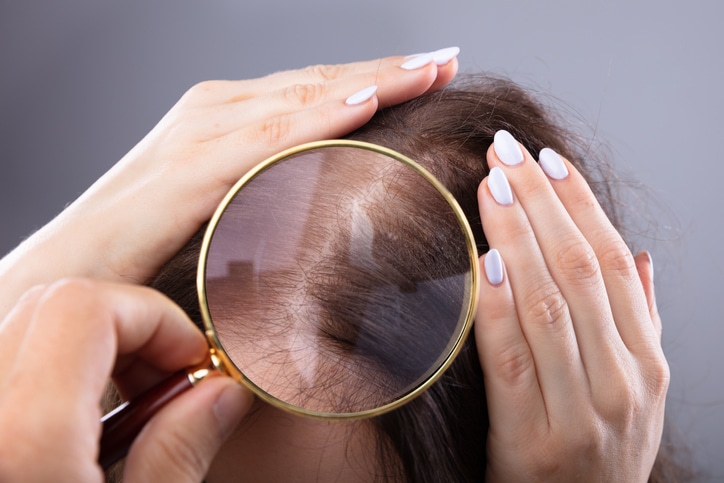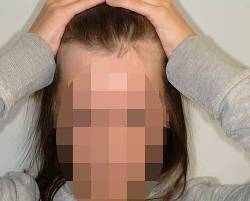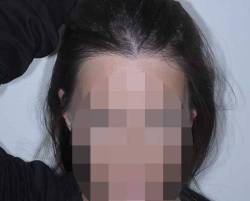Hair loss is not unique to Males Only (Male Pattern Baldness), it also happens on Females ( Female Pattern Alopecia). Dr. Barrera offers hair transplantation to overcome the effects of female hair loss. On females this condition is characterized by hypersensitivity at the hair follicle level to de-hydrotestosterone. This causes a universal thinning of the hair, yet the front hairline remains intact.
What Is Female Pattern Alopecia?
Female Pattern Alopecia is a genetic condition in which there is a hypersensitivity at the hair follicle level to De-hydrotestosterone, generally is a uniform universal thinning with preservation of the front hairline. To be a candidate the patient must have an area of high density, generally that is in the Occipital area, (Back of the head) otherwise we can not do the procedure.
Hair Transplantations
“With the advances in hair transplantation over the past two decades, truly natural results without detectable scarring can be consistently accomplished,” states Dr. Barrera. “Unfortunately hair loss is a progressive condition, we continue to lose our hair as we age, for that reason it is not uncommon to need additional grafts at a later date. The transplanted hair will continue to grow on the grafted area for as long as it was genetically programmed to grow in the donor area, a most encouraging concept!”
Female Hair Loss Treatment
The modern technique of hair transplantation involves the use of very small and numerous grafts called “micrografts” (1-2 hair follicular unit grafts) and minigrafts (3-4 hair follicular unit grafts) in large numbers 1000-2500 or even 2800/ session. Each graft contains then 1-2-3 or up to 4 hairs. The 1 & 2 hair follicular unit grafts are transplanted at the front hairline, and beyond that a mixture of 1-2-3-or 4 hair follicular unit grafts.
Generally, a strip of scalp is taken from the donor area, out of which we make the grafts. The donor area is closed with sutures, if done carefully and closed without tension there is generally minimal scarring at the donor area. The sutures are removed in about 10 days.

What Can I Expect After My Hair Transplant?
The transplanted hair initially grows for about 10 days and then most of it falls out only to re-grow after 3-4 months. By the 5th to 6th month usually, you see significant improvement. It is important that the patient understands this in advance so he or she does not panic with this natural course. So the hair goes into a rest phase initially and after 3-4 months goes into the growth phase and after that, the hair grows for as long a period of time it was genetically programmed to grow on the donor area, a most encouraging finding.
So again for the first 3-4 months, the patient will not look any better, in fact often may look a little worse, because of some of the existing hair, if there was any on the grafted area. often will also shed to some degree.
Dr. Barrera feels that this gradual improvement (growth) is actually a good thing as even people that see you every day do not notice much happening and gradually your hair just looks better.
Micrografts And Minigrafts
Dr. Uebel in 1991 in Brazil introduced the use of micrografts (1-2 hair grafts) and minigrafts (3-4 hair grafts) in large numbers (1000 -1200 grafts) to cover large areas of hair loss such as the entire top of the head in cases of (MPB) Male Pattern Baldness.
Dr. Barrera since that time has been gradually refining such technique by using finer micro blades and further increasing the number of grafts transplanted in a single session –up to 2,500 and even 2800 grafts per session.
Dr. Barrera is frequently invited as a visiting professor and a guest speaker on hair transplantation and aesthetic surgery. Additionally, he has written numerous scientific articles in national journals, and chapters in plastic surgery textbooks by invitation as well as a textbook in hair transplantation.
What causes female pattern alopecia?
Hair loss is normal in everyone as we age. This is true of women and men. Up to two thirds of women experience hair loss after they exit menopause. Less than half of women will make it past age 65 with a full head of hair. It can happen at a younger age, sometimes in the 20’s or 30’s the cause usually is genetics (hereditary), however hormonal imbalances must be ruled out.
How is female pattern hair loss different than in men?
In men, hair loss starts in the front of the head and recedes backwards until the entire area is without hair. Women tend to lose hair from all over the head, starting at the part line. Hair also recedes at the temples. Women are far less likely to go completely bald than men, but there can be extensive thinning.
Doctors break female pattern alopecia into three types:
- Type 1 — A small amount of thinning has started at the part line.
- Type 2 — The part line has widened and there is increased thinning around it.
- Type 3 — There is thinning throughout, and the person has a see-through area at the top of the scalp.
What are the treatment options for female pattern alopecia?
There is no way to reverse or cure female pattern alopecia. At this time, the only FDA-approved option is Minoxidil (brand named Rogaine). Which may help a little.
Dr Barrera feels that a more predictable and definite improvement can be achieved with Hair Transplantation. He continues (over the past 3 decades) improving technique by using and personally himself transplanting individual follicular unit grafts in large numbers (1000-3000). The requirement to do this is having good donor hair density on the back of the head, where we would harvest. This area of the scalp is generally not affected by female pattern alopecia.
Read what our patients are saying!
I am so grateful, not only for your expertise, but also for your genuine kindness and concern. Your Staff along side you, always are welcoming and provide excellent care. Thank you for fitting me into you me into you hectic schedule during this busy holiday season, and for making me look and feel younger!Wishing you a wonderful Christmas and Peter and I look forward to showingand evening together in the New Year.
Click here to read more reviews.
Can a woman prevent female pattern alopecia?
This type of hair loss cannot be prevented, no matter what you may have read in a beauty magazine. This is a genetic condition that changes the growth pattern of the hair follicles and actually shrinks the follicles. There is nothing that can be done to stop it.
Why You Should Choose Dr. Barrera
He has furthermore described multiple other applications for these follicular unit grafts as restoring natural looking hair on the face and scalp on people who had accidents, burns, tumor removals or birth defects being able to restore natural-looking frontal hairlines sideburns, eyebrows, mustaches beard and more recently other body areas.
Dr. Barrera performs all aesthetic surgery procedures including hair transplantation surgery at his Accredited Ambulatory Surgical Facility (AAAASF) under intravenous sedation and local anesthesia, without the need for general anesthesia (painless during the procedure and minimal pain afterwards). This provides added safety and faster recovery. Most patients are able to go home within an hour from the end of the procedure with minimal discomfort.
For further information or questions do not hesitate to contact Dr. Barrera or his staff.
Female Pattern Alopecia Photo Gallery


View Our Female Pattern Alopecia Gallery →
Schedule A Consultation
If you’re interested in learning more about Female Pattern Alopecia in Houston, TX, please contact us at (713) 468-5200 to schedule a consultation with our practice.








